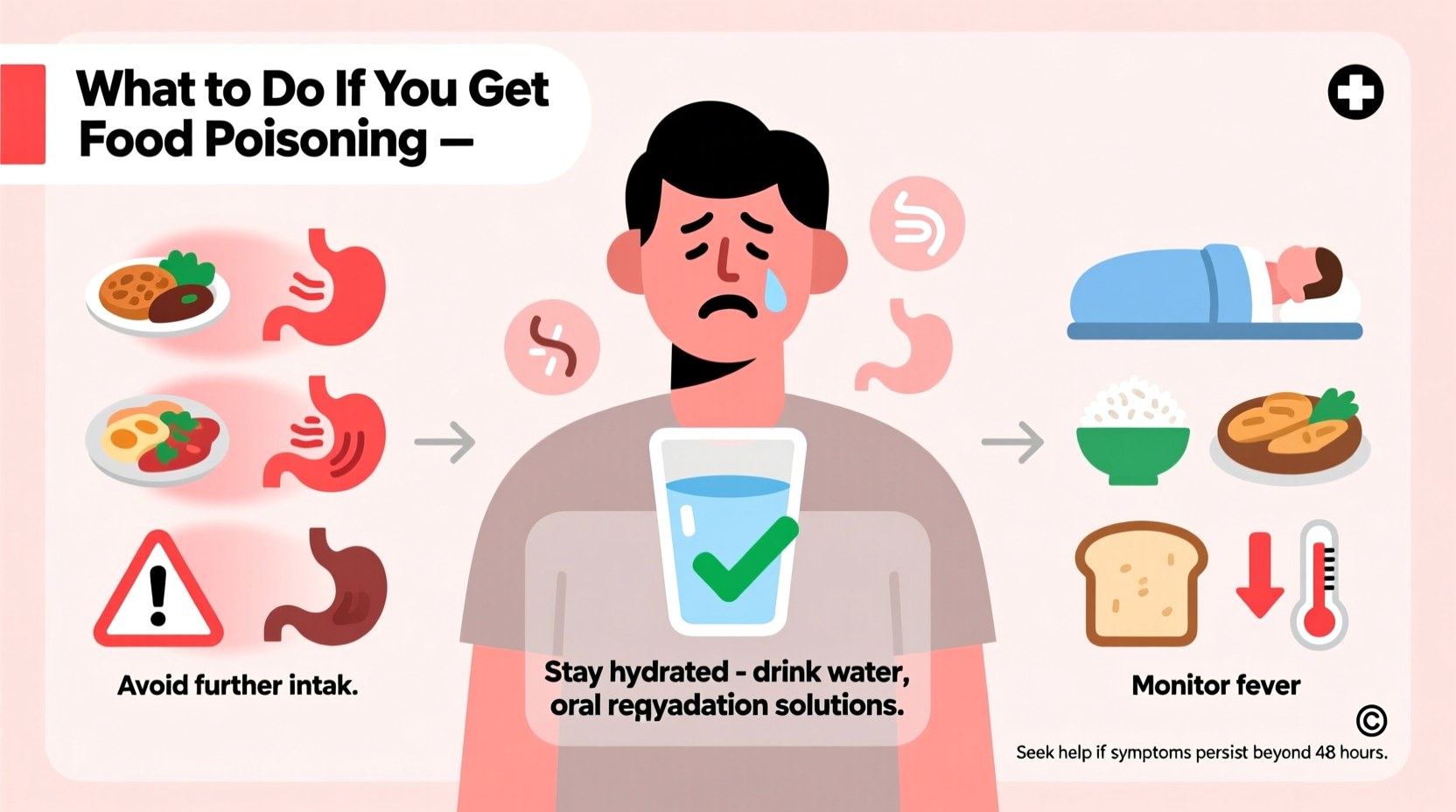Experiencing sudden nausea, vomiting, or diarrhea after eating can be alarming. Food poisoning affects 1 in 6 Americans annually according to the CDC, making it crucial to know exactly what to do when symptoms strike. This guide provides medically-reviewed steps to manage food poisoning safely and effectively.
First 30 Minutes: Immediate Actions for Food Poisoning
When symptoms hit, your first half-hour determines your recovery trajectory. The FDA recommends these critical initial steps:
- Stop all food consumption - Give your digestive system complete rest
- Begin hydration protocol - Take small sips of water or oral rehydration solutions every 5-10 minutes
- Position yourself safely - Sit upright or lie on your side to prevent choking if vomiting occurs
- Preserve evidence - Note what you ate, when symptoms started, and save any remaining food for potential investigation
Avoid common mistakes like taking anti-diarrheal medications immediately or trying to "tough it out" without hydration. Your body needs this initial phase to expel contaminants.

First 24 Hours: Managing Symptoms Strategically
Proper management during the first day significantly impacts your recovery speed. Follow this evidence-based timeline:
| Timeframe | Recommended Action | What to Avoid |
|---|---|---|
| 0-6 hours | Small fluid sips (5-15ml every 5 min), rest | Solid foods, dairy, caffeine, alcohol |
| 6-12 hours | BRAT diet introduction (bananas, rice, applesauce, toast) | Fatty foods, spicy dishes, high-fiber items |
| 12-24 hours | Gradual reintroduction of bland proteins | Raw vegetables, acidic foods, processed sugars |
The Mayo Clinic emphasizes that hydration remains your top priority throughout this period. For every loose stool, replace fluids with 10ml per pound of body weight. Oral rehydration solutions containing electrolytes work better than water alone for severe cases.
Critical Warning Signs: When to Seek Medical Help
While most food poisoning resolves within 48 hours, certain symptoms require immediate medical attention. The CDC identifies these as medical emergencies:
- Signs of severe dehydration (dark urine, dizziness when standing, no urine for 8+ hours)
- Blood in vomit or stool
- Temperature exceeding 101.5°F (38.6°C)
- Symptoms lasting longer than 72 hours
- Numbness, blurred vision, or muscle weakness
Special populations including children under 5, adults over 65, pregnant women, and immunocompromised individuals should contact healthcare providers sooner. According to NHS guidelines, infants with food poisoning can become dangerously dehydrated within hours.
Recovery Timeline and Prevention Strategies
Understanding your recovery progression prevents setbacks. Most foodborne illnesses follow this pattern:
| Phase | Duration | Key Actions |
|---|---|---|
| Acute phase | 12-48 hours | Hydration focus, complete food rest |
| Transition phase | 2-3 days | BRAT diet, gradual food reintroduction |
| Recovery phase | 4-7 days | Normal diet resumption, probiotic support |
Prevent future incidents by following these evidence-based food safety practices:
- Wash hands thoroughly before handling food and after using the bathroom
- Cook meats to proper internal temperatures (use a food thermometer)
- Refrigerate leftovers within 2 hours (1 hour if temperature exceeds 90°F/32°C)
- Separate raw meats from ready-to-eat foods
- Wash produce under running water before consumption
Common Food Poisoning Myths Debunked
Misinformation can worsen food poisoning outcomes. Let's clarify these frequent misconceptions:
- Myth: "The '2-hour rule' doesn't apply if food still smells fine"
Fact: Pathogens like Staphylococcus aureus produce odorless toxins. Food safety depends on time/temperature, not smell. - Myth: "Inducing vomiting helps eliminate toxins"
Fact: The American Association of Poison Control Centers advises against self-induced vomiting, which can cause additional complications. - Myth: "All food poisoning comes from meat"
Fact: Produce accounts for nearly half of foodborne illnesses according to CDC data, with leafy greens being particularly high-risk.
Practical Recovery Tips from Food Safety Experts
While medical guidance forms the foundation, culinary professionals offer these practical recovery enhancements:
- Use ginger tea for nausea relief - studies show ginger reduces vomiting frequency by 38%
- Try the "rice water" method - boiling rice in excess water creates an electrolyte-rich liquid that aids rehydration
- Introduce probiotics after acute symptoms subside - yogurt with live cultures helps restore gut flora
- Clean your kitchen thoroughly after recovery - pathogens can survive on surfaces for days
Remember that food poisoning prevention starts with proper food handling. The FDA's "Clean, Separate, Cook, Chill" framework remains the gold standard for home food safety.











 浙公网安备
33010002000092号
浙公网安备
33010002000092号 浙B2-20120091-4
浙B2-20120091-4